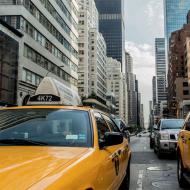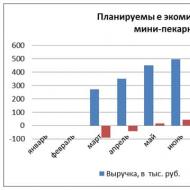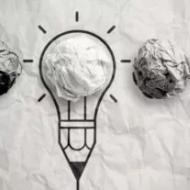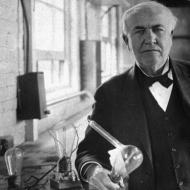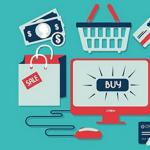
Brand with red and green stripes. Psychology of color perception: How to choose a logo color for your brand? The best music industry logos
Logo color is one of the key elements of a strong brand. Each color has its own characteristics, associations and psychological effects. By choosing a color or combination of colors for your logo, you also gain these associations.
Colors evoke certain emotions and feelings, so it is extremely important to choose a color that effectively represents your personality.
Research shows that people subconsciously form an opinion about a person, environment or product within the first 90 seconds, and that 62% to 90% of this assessment is based on color alone.
Understanding the psychology of color is vital when creating an effective logo - Martin Christie of Logo Design London.
How important is the color of the logo?
The corporate color of the logo is very important! Let’s take, for example, the popular McDonald’s logo and play with color (may the designers forgive us):
Even though we didn't change the design at all, the color change turned a well-known brand into something completely different. And this is something not entirely appetizing.
We can do the same exercise with the Coca-Cola logo:
 You don’t really want to take such a jar of a delicious drink, do you?
You don’t really want to take such a jar of a delicious drink, do you?
The biohazard sign takes on a completely different meaning when shown in Barbie colors or the colors of environmentally friendly materials:
 Even when explicit verbal commands are included, conflicting color symbolism can be misleading.
Even when explicit verbal commands are included, conflicting color symbolism can be misleading.
Just change the color of stop signs to green and it will cause accidents at every intersection. So it’s safe to say that brand colors are very important.

So how do you choose a color to create a logo?
Color meaning
Let's take a look at how the 100 most popular brands in the world use color in their logos.
These companies spend millions, if not billions, on marketing and brand development, and they still know a thing or two about the colors they use.
Here are some charts that show statistics on color usage by well-known companies:
 What do we see? Most popular brands are monochrome - they use one color. The most used color is shades of blue, followed (ironically) by black. The last color on the list, purple, is a risky decision.
What do we see? Most popular brands are monochrome - they use one color. The most used color is shades of blue, followed (ironically) by black. The last color on the list, purple, is a risky decision.
Now that we've cleared that up a bit, let's look at the psychology of different colors - from the most popular to the least popular - and see how famous corporations and brands use them.
Blue color
 Meaning: Trust, conservatism, reliability, honesty, calm, strength, coldness.
Meaning: Trust, conservatism, reliability, honesty, calm, strength, coldness.
Remarkable: The most popular corporate color. Often used for online businesses and financial institutions. Masculine color.
Black color
 Meaning: Sophistication, luxury, formality, style, elegance, high cost, authority.
Meaning: Sophistication, luxury, formality, style, elegance, high cost, authority.
Remarkable: Black is used for “high end” brands, either as a base or paired with another color. Black is gloomy and serious. Most logos were first designed in black and white.
Red color
 Meaning: Courage, passion, strength, attention, love, delight, action, aggressiveness.
Meaning: Courage, passion, strength, attention, love, delight, action, aggressiveness.
Remarkable: Red works equally well on black and white backgrounds. It can mean stop, danger and hot. Exclamation color. Pink colors (shades of red) are considered to be feminine colors.
Yellow
 Meaning: Logical, optimistic, progressive, confident, playful, creative.
Meaning: Logical, optimistic, progressive, confident, playful, creative.
Remarkable: Yellow is usually too bright to be used alone and requires the use of an outline, background or border color. This is the color of caution. Represents clarity.
Orange color
 Meaning: Happy, energetic, outgoing, friendly, approachable, enthusiastic, sunny.
Meaning: Happy, energetic, outgoing, friendly, approachable, enthusiastic, sunny.
Remarkable: Orange is believed to stimulate appetite. The color orange is used in some warning signs. Often used in retail. Typically this is a call to action.
Green color
 Meaning: Nature, richness, freshness, life, harmony, environment, growth, novelty.
Meaning: Nature, richness, freshness, life, harmony, environment, growth, novelty.
Remarkable: Green means “forward.” Often used to represent eco-friendly companies and products. Considered a calming color.
Purple
 Meaning: Royalty, mystery, pomp, ceremony, creativity, uniqueness, majesty.
Meaning: Royalty, mystery, pomp, ceremony, creativity, uniqueness, majesty.
Remarkable: Once the most expensive color to produce, it was made from a rare seaweed. Often seen as elite. Children like it and are often used in packaging sweets and toys.
Combination of colors in the logo
Now that we understand the psychological effects of colors, let's look at how to choose a color for a logo.
We can choose from a range of classic palettes from the color wheel that artists have used for centuries to create balanced and visually pleasing (or high-contrast and vibrant) compositions. In most design applications, these color schemes should be divided into one dominant color (dominant either because of how much it appears in the design or because it stands out when compared to other colors) and one or more complementary colors.
There are several ways to choose a color:
1) Monochrome colors. Various shades, tones of the same color are used, for example, the spectrum of blue, ranging from light to dark. This type of scheme is more subtle and conservative (see picture of the top 100 brands above).
2) Similar colors. Shades that are adjacent on the color wheel. This type of diagram is versatile and easy to use for design development.

3) Complementary (complementary) colors. Opposites on the color wheel, such as red/green or blue/orange; Complementary colors with high contrast and high intensity, but they can be difficult to apply in a balanced and harmonious manner (especially in their pure form, where they can easily clash in a design).

4) Separate-complementary. Any color on the color wheel plus two flanking colors. This scheme has a strong visual contrast, but less sharp than in a complementary combination.

5) Triadic. Any three colors that are the same distance from each other.

6) Tetrad/Doubly complementary. Two pairs that complement each other; This scheme is very attractive, but can be even more difficult than applying one pair of complementary colors, since more colors are more difficult to balance. If you use this type of scheme, you choose one dominant color out of four, and adjust the saturation/value/etc. of some or all of the colors so they work well in different parts of your design, text, and background.

How to choose a color
Look at this to quickly remember the meaning of each color. Ask yourself the following questions:
Which color represents the essence of your brand?
Colors are not tied to a particular area of the economy - although some are more or less suitable for certain products or services. Your goal should be to choose a color that will best suit your business. The color that will give the best impression of your product at first glance.
Which color suits the characteristics of your product or services?
What logo color are your competitors using?
Choose a color opposite to your competitor's. The color of your opponent is probably the most important thing to take into account. If you are a pioneer in your industry or market segment, you can choose first. Choose a color that represents your product and its uniqueness. If you are second, it means someone has already made the first choice. Instead of choosing the same or similar color, choose the opposite one. Choose blue if your competitor has red, choose purple if they have yellow, etc. The power of a brand lies in its ability to stand out. Choosing the same color as your main competitor gives the impression of copying it. You want to separate yourself from your competitor, you want to show that you are different.
Don't limit yourself to one color
Some brands, like eBay, choose multiple colors for their logo. You can also choose a couple of colors that look good together, but there is a risk of getting it wrong. Therefore, it is best to use 1-3 logo colors.
Be aware of differences in cultural perception of your color
For example, in the Western world, white is considered the color of purity and peace, but in some parts of Asia, white is the color of death. Make sure the color you choose will create the right impression on your target audience.
Psychology of color in marketing
Brand recognition is closely related to color. Just think of Coca-Cola, Facebook or Starbucks and I bet you can immediately name the colors they are associated with.
A University of Winnipeg study on "The Impact of Color on Marketing" found that the first judgment about a product is based on color (60-90%, in the first 90 seconds). This means that in design, color is not only an artistic choice, but also an important business decision that affects everything from consumer perception to product sales.
But when choosing a color scheme for a logo or brand, don't be tied to any traditional, symbolic or stereotypical methods. When it comes to color, there is no simple process or strict rule. The most important thing is the color itself and how it is used in the design - whether it suits the brand and the market context. For inspiration, visit BrandColors– a site where a visual guide (with hex colors) is collected on the choice of colors made by famous brands around the world.
Color matching services
 Adobe Color CC lets you try, create, and save different color schemes, each consisting of a set of five colors. It is available in browser and desktop versions. If you're using the desktop version, you can export your color scheme directly into Photoshop, Illustrator, and InDesign.
Adobe Color CC lets you try, create, and save different color schemes, each consisting of a set of five colors. It is available in browser and desktop versions. If you're using the desktop version, you can export your color scheme directly into Photoshop, Illustrator, and InDesign.
 If you're unsure about your color scheme, Mudcube has a selection of themes to choose from. Mudcube Color Sphere is a handy little color resource for designers because it not only provides HEX numbers for each color, but also helps you create a color scheme from a single selected hue. If you're undecided on what color scheme you should choose, MudCube will provide a theme selection from a drop-down menu.
If you're unsure about your color scheme, Mudcube has a selection of themes to choose from. Mudcube Color Sphere is a handy little color resource for designers because it not only provides HEX numbers for each color, but also helps you create a color scheme from a single selected hue. If you're undecided on what color scheme you should choose, MudCube will provide a theme selection from a drop-down menu.
Other services
Color Palette Generator is a free online service that allows you to generate a color palette based on an uploaded PNG, JPG or GIF file.
ColorZilla— with Colorzilla you can use an eyedropper to take a color from anywhere in your browser and determine its number. An indispensable item for designers.
Material UI Colors— color palette for Android, web and iOS in material design style.
Brand Colors - colors used by famous brands.
COLOURlovers— the library of this web resource includes more than 2 million ready-made color solutions, which can be sorted by rating, number of views and date of creation.
Colorscheme is a professional online service that allows you to generate a color scheme in accordance with the rules of color on the color wheel.
0 to 255- this service will allow you to view all possible shades and find the right one.
Logo is a graphic image of a brand. It is created for easy recognition of the company's brand among consumers.
The logo must be unique and of high quality, attracting the attention of the buyer. Logos were created to differentiate products from manufacturers in the same industry.
The KOLORO company develops one-of-a-kind logos.
There are several types of logos:
- “Letter” logo – one or more letters are used.
- Logo “Symbol” - depicted in the form of graphic or alphabetic symbols.
- Logo "Emblem" is a graphic element of image and text.
- Logo "Logoslovo" - consists only of letters.
- Abstract Sign Logo - Creates a visual form of a company's concept using a symbol.
The first logo in the world
The first logo in the world was an image of a dog listening to a gramophone. The dog's name was Nipper.
One of the brothers of the Barro family saw how the dog loved to listen to the Edison-Bell phonograph and decided to capture this moment by drawing a picture “A dog listening to a phonograph.”
In 1900, Marc Barrot's brother, Francis, took Nipper's drawing to a disc gramophone company. The owners of the company really liked the drawing and decided to produce their product with this image. But the original version of the drawing, which depicted a drum gramophone, was replaced with a disk one. The drawing became the first trademark of the companies: “HMV music stores”, RCA, “Victor and HMV records”. The company also began releasing records with Nipper's designs.
The logo currently uses the music channel of the HWV store.
The evolution of global brand logos
Logos of global brands have not always looked stylish and laconic. Some companies, even being popular among consumers, have redrawn their logos. Main reasons:
- change in direction of activity;
- following new trends.
Let's look at a few examples of the evolution of company logos.
- Global Apple Corporation
The company's first logo was an engraving of Isaac Newton under an apple tree, which was surrounded by a large ribbon with the signature "Apple Computer Co" (1976-1977). The designer of this logo was one of the founders of the company, Ronald Wayne. After Ronald left, the logo was changed.
The second Apple logo was made by designer Rob Yanov. Nothing remains of the company’s old logo, except, perhaps, the idea of a fruit falling on Newton’s head. The new Apple logo is a rainbow bitten apple (1977-1998).
The logo that we see now on Apple products was changed in 2007. The “apple” became metallic with reflections, but the shape remained the same.

- Samsung
Samsung means “three stars” in Korean. The company was established in South Korea. The first three logos used stars and the Samsung name.
In 1993, the company decided to create a new logo for its 55th anniversary. It exists to this day. This is a blue ellipse in the center of which “SAMSUNG” is written in white stylized letters.

- Twix bars
The first bars were produced in 1967 in Britain. They were called Raider. But a few years later, in 1979, the name was changed. Raider became Twix. After changing the name, products began to be exported to the USA.
The name Twix is made up of two words, “double” and “biscuit”. Twix bars are very popular all over the world. In Ireland they are still sold under the original name Raider.

- Coca-Cola
Coca-Cola has the most recognizable corporate logo style, which is over 117 years old. The company was founded in 1886 and its logo in 1893. The company logo is written in “Spencer” calligraphy font. It was created by Frank Robinson, an accountant and friend of the company owner.
In the early 1980s, due to competition from Pepsi products, it was decided to change the company's logo to New Coke. After making this marketing move, the company began to lose sales. Consumers did not like the new name of the drink. After some time, the drink was returned to its former name Coca-Cola, thereby improving its sales.

- Pepsi
In 1903, the Pepsi-Cola brand was created. Agree, the company’s first logo is not very pretty. You could say it was a failure.
To prevent this from happening to your brand, you need to turn to a team of professionals at KOLORO, who will help make the logo perfect.
After the Great Depression of the 1930s, Pepsi-Cola was able to prove to Coca-Cola that it could compete on the same level.
In 1962, the company changed its logo to a three-color ball and also removed the Cola prefix. Now it is called only Pepsi. However, the company logo changes very often. What this is connected with is unknown.

- McDonald's
In 1940, McDonald's was created. The company's first logo is an image of a Speedee chef . Later the Speedee logo was redrawn. In the 60s, Jim Spindler changed the company logo to the one we know today. And this is the letter M.

Fashion industry logos (famous fashion brands)
Almost each of us can recognize and name brand monograms. For fashion houses, a logo is very important because most of the fashion houses are named after the founding designers.
- Louis Vuitton
The fashion house was created in 1854. The company's corporate logo is the LV monogram. The color of the monograms and canvas may have changed, but the logo of this brand itself has not changed to this day, except that it was slightly simplified in the 2000s.
The brand's clothing is made from very high quality materials and therefore the products are expensive.
Louis Vuitton brand products are the most copied. But it is very easy to recognize a fake - in the original, the brand logo is always located symmetrically.

- Chanel
The Chanel logo first appeared in 1921. It was depicted on the bottle of Chanel No. 5 perfume. The company's logo is a double letter C. It resembles two wedding rings that are not closed together. The letter C is the initials of Coco Chanel.

- Fendi
The Fendi logo was created in 1972 by the company's new designer, Karl Lagerfeld. The brand logo is a large F that is mirrored.

- Versace
The Versace house logo is very extravagant and extraordinary. It was designed in 1978 by Gianni Versace. The logo represents the head of a representative of ancient Greek mythology - Medusa the Gorgon. The designer explained why he chose this character: “This is a synthesis of beauty and simplicity that can hypnotize anyone, just like the clothes produced by the brand.”

- Givenchy
In 1952, the Givenchy brand began producing high-quality clothing, as well as a line of jewelry and perfumes. The brand logo is very simple and concise. The quadruple G is placed in a square. It looks like Celtic jewelry.

Car brand logos
"Winged" cars:
Bentley- British luxury car. The characteristics of the car can be described in just two words - aristocratic luxury. The car's logo is the letter "B" enclosed in the wings. The emblem indicates the power, speed and elegance of Bentley limousines.

Aston Martin- The car logo was created in 1927. These are eagle wings that frame the Aston Martin inscription. The company's owners compared their car to an eagle. Because the eagle is a fast, agile and predatory bird.

Chrysler- The first logo of American cars was a pentagonal star created in 1923. After the company joined the German concern Daimler AG in 1998, the logo was changed to “open wings.” They demonstrate the virtuosity and uniqueness of Chrysler vehicles.

Cars with animal logo
Jaguar- whose emblem was originally SS - Swallow Sidecar. In English, “swallow” means “swallow.” After the Second World War, most Europeans had negative associations with the SS emblem (association with fascists), so the company owners decided to change the name of the brand. The Swallow Sidecar has been replaced by a Jaguar. Agree, strength, elegance and grace are very suitable for modern Jaguar cars.

Lamborghini— at first the Italian company was engaged in the production of tractors. Therefore, the bull became the emblem of the company. This animal is very hardy and strong. Nowadays, Lamborghini cars are powerful, expensive supercars, and the golden bull emblem suits them very well.

Ferrari— the car logo of this brand is familiar to everyone. Its main attributes are a prancing black stallion on a yellow-gold background with a painted Italian flag at the top of the logo.
The Ferrari emblem was originally on the plane of pilot Francesco Baracca during the First World War. Enzo Ferrari asked Francesco to give him this logo. The pilot agreed and gave Enzo the right to use the logo.

The best music industry logos
Virgin is a British record label. Created in 1972 by Richard Branson and Simon Draper. The name of the label is very interesting. Virgin in English means “virgin”.
The Virgin Records logo (the first company) was created by English illustrator Roger Dean.
A few years later, the Virgin brand became very popular among English performers. After Virgin signed punk rock band the Sex Pistols, Branson decided the company lacked chutzpah. Therefore, it was decided to change the company logo.
Legend has it that one of the artists drew the new logo we know today on a napkin. Branson really liked it. Richard associated the new logo with his company. “Simplicity, attitude and energy are about us,” said Branson.


Sony Music Entertainment- created in 1988 and owned by Sony. One of the "Big Four" record companies in the world. Sony Music covers almost all show business.
The company's first logo was multi-colored, small triangles in the middle of which were the letters SMV. The company logo changed very often. In 2009, Sony Music decided to make the logo completely different. The new logo looks like this: a simple red brush effect on a white background and the text “SONY MUSIC” appears in the appropriate Sony font.

AC/DC- a world famous rock band. Most people may not be familiar with the band's work, but everyone recognizes the AC/DC logo.
Creative director Bob Defrin helped create the logo for the rock band. The font was chosen from the Gutenberg Bible, the first ever printed book.
Huerta's intention was to create an emblem based on the biblical imagery of the AC/DC song "Let There Be Rock." Of course, the lightning and blood red coloration suggest the presence of less angelic influences.

The Rolling Stones are a famous British rock band. Designer John Pache helped create the group's logo. He received 50 pounds for his work. The designer was inspired by Mick Jagger's expressive lips and tongue. It was also inspired by the Hindu goddess Kali.

Queen- British rock band of the mid-1970s. She captivated the hearts of many listeners. The logo was created by the band's lead singer Freddie Mercury. He depicted the letter Q (the name of the group), which is surrounded by the zodiac signs of the band's musicians.
Logo Design Trends 2017
Design trends change almost every season. This applies not only to clothing, makeup and style, but also to trends in logo graphic design.
Logo trends 2017
Minimalism
Many companies resort to this style, because minimalism is simplicity and conciseness. Minimalism uses very few colors. Everything should be simple and executed in the same style, without unnecessary additions.
For example, the well-known application Instagram used this style.
The company's first logo was a black and white image of a Polaroid OneStep camera. In May 2016, the company decided to rebrand not only the logo, but also change the design of the application. Now it's a camera and a rainbow made with a gradient effect.
Gradient colors
Creating a logo with a gradient of colors is a very good move for many companies, because this trend will be at the peak of popularity for a long time. A striking example is the international payment system MasterCard. The company's designers simplified the design and used geometric fills for the logo.

Black and white trend
Black and white design will always be in trend. Laconicism and simplicity of two colors is always a win-win option.
The best example is the world famous brand Nike.
Carolyn Davidson helped create the logo for the brand. The logo features an abstract wing of the goddess Nike.

Geometric figures
To create a unique but at the same time simple logo, designers use geometric shapes that are very easy to perceive and remember.
Example - logo YouTube - a service that provides video hosting services. The brand logo is a “bubble” in the middle of which there is a “play” icon.

Lettering
Quite a simple style. Letters are selected specifically for a specific name or text and are used only once.
Lettering can include a company logo Google. The company's first logo was created in a graphics editor by co-founder Sergey Brin. The designer of the new Google logo style was Ruth Kedar. It was she who came up with the logo design that we know now.

hand drawn
Hand-drawn logos look clear and “folk-like”. Many world famous companies use this style.
Johnson & Johnson- a good example of a new trend for 2017. The company logo is very simple - red text on a white background, handwritten.

Web animated logos
Web animated logos are a trend for 2017. They look very bright, extraordinary. With the help of Gif logos you can attract the attention of consumers.
Disney has been using this trend for a long time. Back in 1985, Tinker Bell began flying over Sleeping Beauty's Castle.
The KOLORO company will develop for you a unique design of your logo, because our specialists are always on the topic of new trends in world design.
The way we perceive and interact with the world is largely determined by the colors around us. In everyday life this is not so noticeable, but in branding the psychology of color has a deep impact on the subconscious of consumers.
The color a company chooses to represent its brand shapes the mood, feelings and behavior of its target audience.
What associations do you have with the color red? A flashy sports car or a ripe strawberry? In any case, red attracts attention.
This strong color has been proven to increase blood pressure and heart rate. It not only energizes, but also stimulates the appetite, making it an excellent choice for the restaurant business.
Red is one of the most emotional colors, so it should be used with caution.
These articles will tell you everything marketers need to know about the psychology of color:
How do you know if red is right for your brand?
Red can be the best choice or the worst choice, depending on your industry, product or service, brand message, and even your competitors' preferences. For example, this color is extremely unpopular in the fields of aviation, energy, and finance.
Below we look at the positive and negative associations with the color red, as well as its impact on brand storytelling.
General associations
The color red in business evokes the following positive associations:
Strong, energetic, fast, passionate, desirable, powerful, lustful, attention-grabbing, bold, motivating, stimulating, determined, exciting, warm, spontaneous, confident, assertive.
Here are examples of negative meanings:
Aggressive, angry, dominant, domineering, exhausting, hot-tempered, ruthless, scary, intolerant, rebellious, stubborn, contemptuous, cruel and brutal.
Shades of red evoke the following associations:

- Dark red– professional, luxurious, commanding
- Light red– exciting, energetic, economical
- Wine- sophisticated, serious, refined
- Crimson– determined, sensitive, energetic
- Scarlet– active, loving, cheerful
- Chestnut– controlled, strong, courageous
Geographical associations
The color red is perceived differently in different countries. Here are some examples:

- IN North America red is associated with Valentine's Day.
- U Cherokee red is associated with success, triumph and sacred fire.
- IN Latin America red is associated with religion (in combination with white).
- IN South Africa red is the color of mourning.
- IN Nigeria red is worn only by high-ranking officials and is used in ceremonies.
- IN Russia red is associated with communism and beauty.
- IN China The color red is associated with good luck, celebration, happiness, cheerfulness and long life. Traditionally, the bride wears an outfit of this color to her wedding.
- IN Thailand red is the color of Sunday.
Red color for different industries
Red in the food industry
Red energizes the body and awakens the appetite. That's why this color is an excellent solution for food business.
For example, in such famous logos as Coca-Cola, McDonald's, KFC, Lay's, RedBull, the dominant color is red.

Red for sexy brands
Red attracts attention. It is often associated with love, passion and sexuality, which is why it is popular with sensual brands: Vans, H&M, Virgin, Miss sixty.

Red and masculinity
Red is usually associated with basic physical needs and awakens ancient instincts, it radiates masculine energy. Therefore, it is often chosen by masculine brands, for example, Audi, Nissan, Marlboro, Dodge.

Red for sales
Red is a vibrant color and enhances the sense of urgency, making it great for clearance brands like Auchan, Target, Pyaterochka.

When fans identify your brand, they first associate it with your logo. And their perception, in turn, largely depends on color. The right logo color can enhance (or detract from) your product branding marketing strategy.
As a study by WebPageFX has shown, consumers form an unconscious attitude towards a product with it, and in 85% of cases their judgment is based precisely on the perception of color.
Logos used by successful companies cover the entire spectrum of colors. However, the relationship between a successful choice of color and its perception is very clear.
Let us consider the study of color psychology in more detail - using the example of the main and most common colors of the spectrum: red, yellow and blue, as well as their derivatives orange, yellow and violet.
RED
Among all other colors, red evokes perhaps the strongest associations in humans, symbolizing at the same time love, blood, heat, danger, aggression, urgency and prohibition. It enhances any feelings, excites the nervous system and stimulates decisive action.

Impact on feelings
- Warms up passion, feelings and emotions
- Attracts attention
- Increases blood pressure and heart rate
Role in Marketing
- Stimulates appetite and calls to action
- Creates a sense of urgency and urgency
- Used to stimulate
Brands using red logos
McDonald's, Lays, Lego, Pinterest, Heinz, Youtube, H&M, Nintendo, Virgin, Adobe, Coca-Cola, Toyota, Gmail and others.
YELLOW
Yellow is the color of gold, sun, bread, butter and lemons. Represents prosperity, warmth and light, and, like red, stimulates the senses and awakens. Symbolizes hope and optimism.

Impact on feelings
- Stimulates the nervous system
- Stimulates communication
- If used in excess, it strains vision and tires the eyes.
Role in Marketing
- Promotes a feeling of clarity and improves thought processes
- Brings joy and happiness
- Can make children cry
Brands using yellow logos
Nikon, National Geographic, Shell, Hertz, AOL, CAT, DHL, IKEA, IMDB and others.
BLUE
The most suitable color for a business environment. Carries associations with calmness and purity of water and air. Calms the senses and lowers blood pressure. Instills trust, a feeling of clarity and verification.

Impact on feelings
- Restrains emotions and appetite
- Increases performance
- Associated with coolness and tranquility
Role in Marketing
- Preferred mainly by men
- Brings security and trust
- Most common in office culture
Brands using blue logos
Facebook, Twitter, LinkedIn, Pepsi, Oreo, Skype, Vimeo, Oral-B, Flickr, Microsoft Word, Ford, General Electric, DELL and others.
ORANGE
Situated on the spectrum between red and yellow, orange gets its name from the French word for orange, symbolizing warmth and stimulating the nervous system. Associated with vitality, abundance and balance.

Impact on feelings
- Creates a surge of energy and enthusiasm
- Warms and promotes confidence
- Attracts attention
Role in Marketing
- Used for strong, aggressive campaigns
- Encourages active action
- Creates an atmosphere of friendship, fun and trust
Brands using orange logos
Nickelodeon, Fanta, Amazon, Firefox, Blogger, Microsoft PowerPoint, Bing, Harley-Davidson and others.
GREEN
Green color brings freshness and coolness to the foliage. For consumers it is associated with nature, health and good luck.

Impact on feelings
- Relaxes, calms and relieves stress
- Relieves pain and depression
- Refreshes and renews
Role in Marketing
- Associated with health and procreation
- symbolizes naturalness and environmental friendliness
- Means newness, “young shoots”
Brands using green logos
Starbucks, Android, Microsoft Excel, Evernote, Whole Foods, Animal Planet, Spotify, Xbox, Land Rover, Holiday Inn and others.
VIOLET
In most cases, purple is a calm and peaceful color. In modern culture, it symbolizes spirituality, magic and royalty.

Impact on feelings
- Associated with success and wisdom
- Symbolizes power and arrogance
- Promotes hypnosis and charm
Role in Marketing
- Used in products for children and older adults
- Gives calm and balance
- Creates an atmosphere of creativity, wisdom and spirituality
Brands using purple logos
Yahoo!, T-Mobile, Hallmark, Viber, Milka, Craiglist and others.
Conclusions: Which logo color is most suitable?
There is no single right color for your logo. Determine for yourself what values your product conveys, what associations it should evoke in your consumers, and what color will help you enhance the feelings you need and create a strong emotional connection. And the logos of large brands that spend colossal sums on such research will help you make sure that your choice is correct or that you need to determine a different direction.
Incredible facts
Every day we come across hundreds of logos, and we can just look at them for a second and not think about what this or that logo actually means.
It is worth noting that a lot of time and millions of dollars were spent on the development of some famous logos, even very simple ones, and the meaning embedded in them is far from simple.
Let's take the logo as an example. Sony Vaio, invented Timothy Hanley(Timothy Hanley). This is one of the best logos with a hidden meaning that can be understood if you are even a little computer savvy.

The left side of the logo depicts a wave, symbolizing analog signal.
The right side of the logo contains the numbers "1" and "0", which symbolizes digital signal.
And if you're wondering, VAIO is an acronym for Video Audio Intelligent Organizer.
FedEx company logo
- the arrow will indicate the speed

The FedEx logo consists of two words: "Fed" in purple and "Ex" in orange. It may seem like there is nothing smart here. Then why has this logo been awarded so many awards? It's all about the use of negative space - in the word FedEx, the letters "E" and "x" are positioned so that an arrow forms in the space between them.
Logo creation
This logo took months to create. It also led to a completely new type of form. On a subconscious level, this logo turned out to be very effective. Many people do not notice the arrow, but perceive it subconsciously, associating it with speed, which is what the company is striving for.
McDonald's logo
- female breasts awaken hunger

Many people simply perceive a company's logo as the first letter of its name. In principle this is true, but not all. Subconsciously, some people associate the rounded letter "M" with their mother's breasts.
Logo development
In the 60s, McDonald's was revamping its image, and this included developing a new logo. Louis Cheskin, a psychologist and design consultant hired by the company, convinced management to keep their logo, explaining that the arches in the logo had a Freudian effect, i.e. clients imagined breastfeeding, which made them feel hungry.
It may be hard to believe, but now you will look at the big “M” in a completely different way.
Museum of London logo
- history in all its colors

The Museum of London's goal is to show the history of the capital in all eras, from the Middle Ages to the present day. In 2010, the museum needed updating to become interesting for a younger audience.
Corporate logo
The new logo, of course, also had to do its job, and it did, thanks to its bright colors and its hidden meaning. Just looking at the new logo, a picture of London comes to mind.
In the logo image you can see several colorful layers that depict the evolution of the city. Each layer is an outline of London in a certain era.
Adidas company logo
- faster, higher, stronger!

The Adidas company produces sportswear and paraphernalia, but is best known for its sports shoes. The word Adidas comes from the merger of the first and last names of its creator, Adolf Dassler.
From the very beginning, the company began to actively engage in marketing, and literally immediately its motto became the phrase “a brand with 3 stripes.” Over time, the logo changed, but it always featured three stripes.
Sports logo
Today, the company's logo includes three stripes arranged in a triangle, which symbolizes a mountain - a metaphor that means conquering new peaks and achieving new goals.
Mitsubishi logo
- family values come first

Initially, in the 1800s, Mitsubishi positioned itself as a transport company. It was created by two Japanese families and its logo symbolizes exactly that. The word Mitsubishi comes from mitsu - “three”, “hishi” - “water chestnut” (according to the rules of Rendaku, this part of the word is read as “bishi”).
Clan logos
The company's logo is created from two coats of arms: the three-leaf crest of the Tosa clan and the family crest of the Iwasaki family, which depicts three diamonds stacked on top of each other. Three diamonds symbolize reliability, integrity and success, and their red light symbolizes confidence and helps attract clients.
Google logo
- be a rebel, don't play by the rules!

On the one hand, the Google logo looks simple - simple colors, normal font, no hidden symbols. But it is simple colors that influence the image of the company.
Logo format
When creating the Google logo, the designers wanted to portray playfulness without symbols or large objects. The secret of the logo is contained in the colors in which the letters are painted - the main colors were chosen (blue, yellow and red), which follow a certain pattern, but the green letter “l” breaks the logic.
The illogical green color in the color scheme symbolizes non-standardism and unwillingness to play by the rules.
Animal Planet channel logo
- wild nature and primitiveness

The channel's first logo included an elephant reaching for the Earth - everything is quite simple: an animal and a planet. In 2008, the channel was relaunched in order to become more attractive to a larger audience. This also meant a logo change.

With its second life, the channel had to become more entertaining, and be associated with a place where there are no boring documentaries, but only exciting reports and programs. This idea needed a new, appropriate logo.
Channel logo
The new logo symbolizes instinct, and when you see the greenish letters, you can’t help but think about the jungle, primitive emotions and “animal courage.” Quite a lot of emotions for a channel name that has one inverted letter.
NBC channel logo
- buy, buy!

NBC's logo is a peacock, and it's no secret, but no one asks why a peacock. All this was a marketing gimmick to get people to buy color TVs.
At the time, the channel was owned by the electronics company Radio Corporation of America (RCA). At the time, color televisions were just beginning to appear on the market, and RCA wanted to show viewers that the relatively high price of such televisions was worth buying them and being amazed by the vibrant colors.
Logo design
It was necessary to come up with a logo that would make people appreciate color, and think about the fact that their black and white TVs had a clear disadvantage.
The rainbow as a logo was immediately dismissed as too obvious, butterflies were considered boring, and so the peacock appeared, which was also used in the catchphrase “proud as a peacock.”
Amazon logo
- diversity and smiles

Like most logos, this one is quite simple at first glance. The Amazon.com company name is in black with a simple curved yellow line underneath it. Well, what does this little arrow mean?
Organization logo
The logo actually means two things. Firstly, it is the smile of customers who are satisfied with their purchase on the site. The yellow line and its shape highlight each of the two "a's" in the word "Amazon," which act as eyes.
The same line symbolizes an arrow that starts from the letter "a" (the first letter of the English alphabet) and extends to the letter "z" (the last letter of the English alphabet), which symbolizes the diversity of species in the Amazon rainforest.
At one point, the designers depicted an arrow that started with the letter "a" and became thicker as it approached the letter "z", but it was later changed because they thought it resembled a phallus.
Pepsi logo
- the whole world in one circle

The logo of this company is a simple circle, the upper half of which is red, the lower half is blue, and a wavy white line runs between them.
Obviously the colors represent the American flag, but that's just the tip of the iceberg. Pepsi spent hundreds of millions of dollars developing its current logo. While it's similar to previous logos, it's been changed a bit to (apparently) make even more sense.
Logo price
To develop the new logo, Pepsi hired a branding agency, which presented a 27-page report explaining the myriad of meanings embedded in the new logo.
According to this document, the new logo signifies the Earth's magnetic field, Feng Shui, Pythagoras, geodynamics, probability theory, and much more.

You can’t help but wonder if the logo works as the agency says, or if they just made it up for the sake of a big check.

